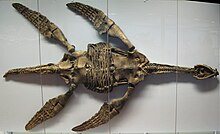Meyerasaurus
Appearance
| Meyerasaurus Temporal range: Early Jurassic,
| |
|---|---|

| |
| The holotype in the State Museum of Natural History Stuttgart | |
| Scientific classification | |
| Domain: | Eukaryota |
| Kingdom: | Animalia |
| Phylum: | Chordata |
| Class: | Reptilia |
| Superorder: | †Sauropterygia |
| Order: | †Plesiosauria |
| Family: | †Rhomaleosauridae |
| Genus: | †Meyerasaurus Smith & Vincent, 2010 |
| Species: | †M. victor
|
| Binomial name | |
| Meyerasaurus victor (Fraas, 1910 [originally Plesiosaurus])
| |
| Synonyms | |
| |
Meyerasaurus is an extinct genus of plesiosaur. An almost complete fossil was found in Holzmaden, Baden-Württemberg, southeastern Germany.[1] It was a medium-sized, 3.35 m (11.0 ft) long, pliosaur.
The specimen was collected from shale over 150 years ago. The shale dates to the early Jurassic, about 183–180 million years ago (mya).[1] The specimen was described as a species of Plesiosaurus a hundred years ago.[2] It got its new name in 2010.[1]
Most members of its family, the Rhomaleosauridae, have been found in England. They were found in the lower Blue Lias deposits which date to the earliest Jurassic, just above the boundary with the Triassic.
References
[change | change source]- ↑ 1.0 1.1 1.2 "A new genus of pliosaur (Reptilia: Sauropterygia) from the Lower Jurassic of Holzmaden, Germany" (PDF). Palaeontology. 53 (5): 1049–1063. 2010. doi:10.1111/j.1475-4983.2010.00975.x. S2CID 54887772.
{{cite journal}}: Unknown parameter|authors=ignored (help) - ↑ Fraas E. 1910. Plesiosaurier aus dem oberen Lias von Holzmaden. Palaeontographica, 57, 105–140.
